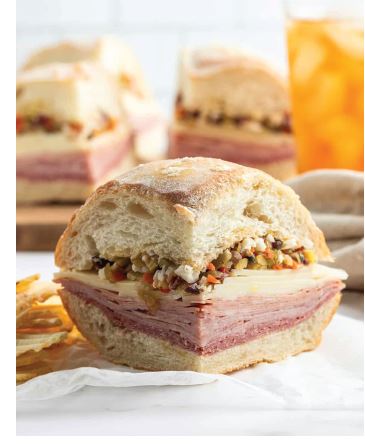What is Italian in origin, piled high with meats and cheeses, and round all over? If you guessed the muffuletta (pronounced muh-fuh-leh-tuh) sandwich, you win a gold star. There may be differences in spelling and in the stories surrounding its arrival on Galveston Island, but what isn’t debatable are its contents and origin.
What’s in a name? The muffuletta (or muffaletta, moffoletta, muffoletto, muffulietta, depending on local speech) derives its name from Sicilian dialect that means “soft and spongy round bread.” Although the sandwich is Italian in spirit and style, it is American born.
All tales of the sandwich’s creation lead back to New Orleans, Louisiana, where a large group of Italian immigrants settled in the late-18th and early-19th centuries. This section of the French Quarter was referred to as “Little Palermo” and the “Italian Sector.”
Ranging in size from 14-18 inches in diameter, this hearty sandwich is piled high with Italian meats and cheeses and assembled on a round loaf of sturdy bread topped with sesame seeds and slathered with an olive relish or a pickled vegetable tapenade.
The cold cuts of meat include assorted salumi—an Italian array of cured meats like mortadella, salami, pancetta and ham—and provolone, mozzarella and/or parmesan cheeses.
No matter the meat and cheese choices, a proper muffuletta always features a pickled spread that includes a mash of olives and sometimes other vegetables, like cauliflower and carrots, called a giardiniera, which is spread liberally on the bread.
Several island eateries serve muffulettas year ’round, and others serve them during Mardi Gras season only. Some serve traditional muffuletta ingredients in other, more creative dishes, like Gypsy Joynt’s muffuletta pizza. The brainchild of owner Lori Weller, this hearty pizza is piled high with mortadella, salami, ham, and provolone atop house-made olive relish.
“Mom likes to deconstruct classic dishes and create something new and innovative,” her son Jordan Weller said.
He and his wife, along with co-manager, Evangeline, credit Lori with the invention of what they call “Mardi Gras on a plate.” They also offer a special savory King Cake with muffuletta ingredients that is offered during Mardi Gras season and by special-order only. The pizza is on the menu year ’round.
Papa’s Pizza has been serving muffuletta sandwiches since “the first day we opened our doors in the mid ’90s,” said Galveston Restaurant Group manager Joey Pottie. “The key is using the right bread and treating it the right way–toasted on top and soft in center.”
Papa’s buys their muffuletta bread from a local bakery but preferred to keep that information to themselves. They also make their olive tapenade in-house.
Maceo Spice & Import Company sells more than 100 muffuletta sandwiches a day and twice that during Mardi Gras season said spokesperson Concetta Maceo-Sims. In addition to the sandwich itself, Maceo’s sells Italian cured meats and cheeses used in the sandwich and bottles their own olive salad.
Their bun is baked in a local bakery with the family’s secret recipe that is used exclusively by them. The Maceos have a long-standing history in Italian tradition and the city of New Orleans; they credit patriarch R.S. and his son Frank with creating and bringing the sandwich to Galveston.
 Other family-owned and long-standing restaurants claim to have brought the sandwich to Galveston Island. Who is correct? We have no idea of knowing. What do we know? This American born sandwich that is Italian in spirit and style is here to stay.
Other family-owned and long-standing restaurants claim to have brought the sandwich to Galveston Island. Who is correct? We have no idea of knowing. What do we know? This American born sandwich that is Italian in spirit and style is here to stay.
MAKE A MUFFULETTA AT HOME
Olive Spread
16 oz. jar of pitted olives (black and green)
½ cup of Italian dressing
¼ cup shredded parmesan cheese
12 oz. of baby carrots
8 oz. jar of giardiniera salad (Or make your own with capers, roasted and seeded red peppers; pickled cauliflower, garlic, and parsley in a brine.)
Meats and Cheese
¼ pound of mortadella
¼ pound of ham
¼ pound of salami
¼ pound of one provolone or mozzarella
Bread
Don’t be discouraged if you can’t find the traditional round bread; a hearty loaf of Italian or French bread will do.
Place all ingredients for the olive spread in a food processor and pulse until you get a chunky spread that is smooth enough to coat the bread generously. Slather both sides of the bread with the olive spread.
Pile layers of meat and cheese. Wrap in foil and bake in a 350-degree Fahrenheit oven for 30 minutes, or until warmed through and cheese is melted.
Slice and serve. For a variation, mix the traditional muffuletta ingredients with pasta and bake as a casserole.